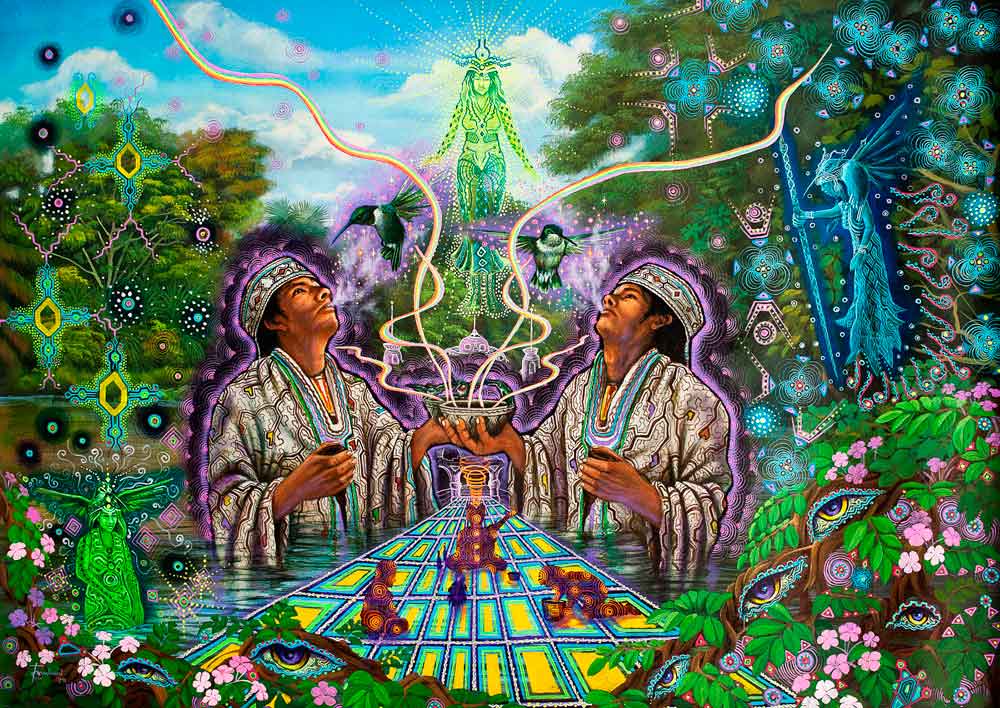
Ayahuasca, also known as “the medicine of the jungle”, is a powerful sacred drink used by the indigenous tribes of the Amazon for thousands of years. In recent times, it has gained popularity in various parts of the world due to its psychedelic properties and its supposed therapeutic benefits.
The Origin and Ingredients of Ayahuasca
“Ayahuasca” is a word that comes from two Quechua terms: “aya” which means “spirit” and “huasca” which means “vine”. This spiritual drink is made from the mixture of two plants: the Banisteriopsis caapi liana, known as “ayahuasca” or “yagé”, and the leaves of the Psychotria viridis plant, called “chacruna”.
The Journey of Ayahuasca and its Effects on Consciousness
When Ayahuasca is consumed, its active ingredients trigger an intense and transformative psychedelic experience. The dimethyltryptamine (DMT) present in the leaves of the chacruna is potentiated by the monoamine oxidase inhibitors (MAOIs) contained in the ayahuasca liana. This allows DMT to be absorbed through the digestive system and reach the bloodstream, thus reaching the brain.
The Therapeutic Benefits of Ayahuasca
Ayahuasca has traditionally been used for therapeutic and ceremonial purposes. It is believed that this sacred plant can help in emotional and spiritual healing, as well as in the expansion of consciousness. Many users report deep experiences of introspection, connection with nature, and revelations about themselves and the universe.

Ayahuasca and its Use Today
In recent decades, Ayahuasca has attracted the attention of researchers, therapists and people interested in the exploration of consciousness. Several studies suggest that this plant may have positive effects in the treatment of disorders such as depression, anxiety and post-traumatic stress. However, it is important to note that Ayahuasca is not a recreational substance and should be taken in a suitable environment and with the guidance of trained professionals.
Considerations and Precautions
Although Ayahuasca may offer therapeutic benefits, it also carries risks and side effects. Ayahuasca travel can be intense and challenging, and people may experience nausea, vomiting, and dizziness. In addition, Ayahuasca can interact negatively with certain medications and medical conditions, so it is essential to inform the facilitator about any pre-existing medications or conditions.
The Importance of a Responsible Approach
Due to the increase in popularity of Ayahuasca, there has been a growth in retreats and ceremonies in various parts of the world. It is essential that people who wish to experiment with Ayahuasca do so in safe environments and with experienced guides. Ayahuasca should not be taken lightly, as it can trigger profound and sometimes challenging experiences.

Conclusions
Ayahuasca is an ancestral tool that has been used for centuries by indigenous communities to explore awareness and promote healing. Its contemporary appeal lies in its ability to provide deep experiences of introspection and connection with the divine. However, its use must be approached with responsibility and respect, as it can have both positive and challenging implications for those venturing out on their journey. Ayahuasca offers a path to expanding consciousness, but only those who are willing to explore it consciously and safely will be able to fully take advantage of its potential therapeutic and spiritual benefits.









